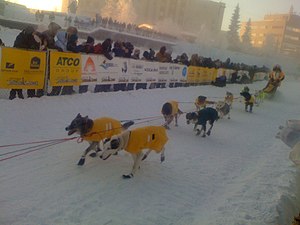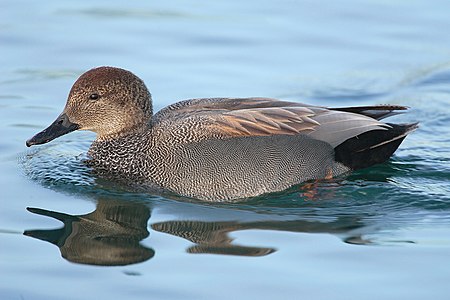Portal:Canada
| Showcase | Contents | Contributing |
Introduction
Canada is a country in North America. Its ten provinces and three territories extend from the Atlantic Ocean to the Pacific Ocean and northward into the Arctic Ocean, making it the world's second-largest country by total area, with the world's longest coastline. Its border with the United States is the world's longest international land border. The country is characterized by a wide range of both meteorologic and geological regions. With a population of just over 41 million people, it has widely varying population densities, with the majority residing in urban areas and large areas of the country being sparsely populated. Canada's capital is Ottawa and its three largest metropolitan areas are Toronto, Montreal, and Vancouver.
Canada is a parliamentary democracy and a constitutional monarchy in the Westminster tradition. The country's head of government is the prime minister, who holds office by virtue of their ability to command the confidence of the elected House of Commons and is appointed by the governor general, representing the monarch of Canada, the ceremonial head of state. The country is a Commonwealth realm and is officially bilingual (English and French) in the federal jurisdiction. It is very highly ranked in international measurements of government transparency, quality of life, economic competitiveness, innovation, education and human rights. It is one of the world's most ethnically diverse and multicultural nations, the product of large-scale immigration. Canada's long and complex relationship with the United States has had a significant impact on its history, economy, and culture.
A developed country, Canada has a high nominal per capita income globally and its advanced economy ranks among the largest in the world by nominal GDP, relying chiefly upon its abundant natural resources and well-developed international trade networks. Recognized as a middle power, Canada's strong support for multilateralism and internationalism has been closely related to its foreign relations policies of peacekeeping and aid for developing countries. Canada is part of multiple international organizations and forums. (Full article...)
Featured article -

The Yukon Quest, formally the Yukon Quest 1,000-mile International Sled Dog Race, is a sled dog race scheduled every February since 1984 between Fairbanks, Alaska, and Whitehorse, Yukon, switching directions each year. Because of the harsh winter conditions, difficult trail, and the limited support that competitors are allowed, it is considered the "most difficult sled dog race in the world", or even the "toughest race in the world"—"even tougher, more selective and less attention-seeking than the Iditarod Trail Sled Dog Race." The originator envisioned it as "a race so rugged that only purists would participate." (Full article...)
Featured biography -
Ujjal Dev Dosanjh PC KC (/ˈuːdʒəl doʊˈsɑːndʒ/; born September 9, 1947) is a Canadian lawyer and politician. He served as the 33rd premier of British Columbia from 2000 to 2001 and as a Liberal Party of Canada member of Parliament from 2004 to 2011. He was minister of health from 2004 until 2006, when the party lost government. He then served in the Official Opposition from January 2006 until 2011. Dosanjh was one of four visible minorities to serve in Paul Martin's Ministry. (Full article...)
Selected panorama -
Panoramic view of Mont-Tremblant, Quebec
Credit: Acarpentier (Alain Carpentier)
National symbol -
A Caesar is a cocktail created and consumed primarily in Canada. It typically contains vodka, Clamato, hot sauce, and Worcestershire sauce, and is served with ice in a large, celery salt-rimmed glass, typically garnished with a stalk of celery and wedge of lime. What distinguishes it from a Bloody Mary is the inclusion of clam broth. The cocktail may also be contrasted with the Michelada, which has similar flavouring ingredients but uses beer instead of vodka. (Full article...)
Selected vital article -
The wildlife of Canada or biodiversity of Canada consist of over 80,000 classified species, and an equal number thought yet to be recognized. Known fauna and flora have been identified from five kingdoms: protozoa represent approximately 1% of recorded species; chromist (approximately 4); fungis (approximately 16%); plants (approximately 11%); and animals (approximately 68%). Insects account for nearly 70 percent of documented animal species in Canada. More than 300 species are found exclusively in Canada. (Full article...)
Selected picture -
Current events
- January 1, 2025 – Foreign relations of Mexico
- Mexico's Tax Administration Service implements new tariffs, including a 19% duty on goods from countries without international trade agreements with Mexico and a 17% duty on goods from Canada and the United States under certain value thresholds. (Reuters)
- December 16, 2024 – Resignation of Chrystia Freeland
- Chrystia Freeland resigns as Canada's Deputy Prime Minister and Minister of Finance amid disagreements with Prime Minister Justin Trudeau on increased government spending and how to handle possible U.S. tariffs imposed by the incoming Trump administration. (Reuters)
- December 11, 2024 – Russo-Ukrainian War
- The Parliament of Canada approves the allocation of CA$764 million (US$587 million) in military aid to Ukraine. (Ukrainska Pravda)
- December 3, 2024 – Red Sea crisis
- The Government of Canada officially designates the Yemen-based Houthi movement as a terrorist organization due to the group's attacks on civilian and military vessels in the Red Sea. (Al Jazeera)
- November 20, 2024 – November 2024 Northeast Pacific bomb cyclone
- Two people are killed and more than 570,000 people are without power when a bomb cyclone makes landfall over the West Coast of the United States and British Columbia, Canada. (CNN) (NBC News)
- November 15, 2024 –
- The Canadian Union of Postal Workers go on strike after failing to renegotiate their contract with Canada Post. (AP)
Did you know -

- ... that research conducted in 2020 found that squirrels are "nearly ubiquitous" on college campuses in the United States and Canada?
- ... that the Canadian Coalition for Firearm Rights has been described as "Canada's most prominent pro-gun group"?
- ... that the inclusion of the Canadian song "How Long" in a bootleg Russian DVD resulted in a sixteen-year search for the track's creator?
- ... that in one year, a team of Canadian All-Stars twice played against the U.S. college football national champion and came within one point of winning each game?
- ... that during combat, the Canadian-designed SW1C radar failed to find not only its U-boat target, but also an iceberg near the ship?
- ... that as a teenager in a B'nai B'rith camp in Canada, Holocaust survivor and future Canadian ambassador Fred Bild learned English from his camp counselor, future actor William Shatner?
- ... that a year after becoming the first woman president of the Canadian Political Science Association, Caroline Andrew moderated the first Canadian leaders' debate on women's issues?
Featured list -
The Northern Star Award, formerly known as the Lou Marsh Trophy, the Lou Marsh Memorial Trophy and Lou Marsh Award, is a trophy awarded annually to Canada's top athlete, professional or amateur. It is awarded by a panel of journalists, with the vote taking place in December. It was first awarded in 1936, named in honour of Lou Marsh, a prominent Canadian athlete, referee, and former sports editor of the Toronto Star. The trophy is made of black marble and stands around 75 centimetres high. The words "With Pick and Shovel" (the name of Marsh's long-running Star column) appear above the engraved names of the winners. The voting panel consists of sports media voters from across the country including representatives from the Toronto Star, The Canadian Press, FAN590, The Globe and Mail, CBC, Rogers Sportsnet, CTV/TSN, La Presse and the National Post. (Full article...)
Main articles
Associated Wikimedia
The following Wikimedia Foundation sister projects provide more on this subject:
-
Commons
Free media repository -
Wikibooks
Free textbooks and manuals -
Wikidata
Free knowledge base -
Wikinews
Free-content news -
Wikiquote
Collection of quotations -
Wikisource
Free-content library -
Wikiversity
Free learning tools -
Wikivoyage
Free travel guide -
Wiktionary
Dictionary and thesaurus






























